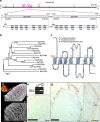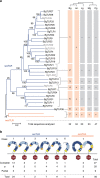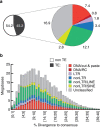Whole genome analysis of a schistosomiasis-transmitting freshwater snail
- PMID: 28508897
- PMCID: PMC5440852
- DOI: 10.1038/ncomms15451
Whole genome analysis of a schistosomiasis-transmitting freshwater snail
Erratum in
-
Corrigendum: Whole genome analysis of a schistosomiasis-transmitting freshwater snail.Nat Commun. 2017 Aug 23;8:16153. doi: 10.1038/ncomms16153. Nat Commun. 2017. PMID: 28832025 Free PMC article.
Abstract
Biomphalaria snails are instrumental in transmission of the human blood fluke Schistosoma mansoni. With the World Health Organization's goal to eliminate schistosomiasis as a global health problem by 2025, there is now renewed emphasis on snail control. Here, we characterize the genome of Biomphalaria glabrata, a lophotrochozoan protostome, and provide timely and important information on snail biology. We describe aspects of phero-perception, stress responses, immune function and regulation of gene expression that support the persistence of B. glabrata in the field and may define this species as a suitable snail host for S. mansoni. We identify several potential targets for developing novel control measures aimed at reducing snail-mediated transmission of schistosomiasis.
Conflict of interest statement
The authors declare no competing financial interests.
Figures





References
-
- Paraense W. L. The schistosome vectors in the Americas. Mem. Inst. Oswaldo Cruz 96, (Suppl): 7–16 (2001). - PubMed
-
- Doenhoff M. J. et al. Praziquantel: Its use in control of schistosomiasis in sub-Saharan Africa and current research needs. Parasitology 136, 1825–1835 (2009). - PubMed
-
- Rollinson D. et al. Time to set the agenda for schistosomiasis elimination. Acta Trop. 128, 423–440 (2013). - PubMed
Publication types
MeSH terms
Substances
Grants and funding
- R01 AI101438/AI/NIAID NIH HHS/United States
- U41 HG002371/HG/NHGRI NIH HHS/United States
- HHSN272201400029C/AI/NIAID NIH HHS/United States
- R25 GM075149/GM/NIGMS NIH HHS/United States
- R21 AI111201/AI/NIAID NIH HHS/United States
- R25 GM060201/GM/NIGMS NIH HHS/United States
- R01 GM061738/GM/NIGMS NIH HHS/United States
- U54 HG003079/HG/NHGRI NIH HHS/United States
- R01 AI015503/AI/NIAID NIH HHS/United States
- R01 AI109134/AI/NIAID NIH HHS/United States
- HHSN272201000005C/AI/NIAID NIH HHS/United States
- R01 GM077582/GM/NIGMS NIH HHS/United States
- R21 AI016137/AI/NIAID NIH HHS/United States
- P30 GM110907/GM/NIGMS NIH HHS/United States
- T32 AI007414/AI/NIAID NIH HHS/United States
- R01 AI016137/AI/NIAID NIH HHS/United States
- G0900802/1/NC3RS_/National Centre for the Replacement, Refinement and Reduction of Animals in Research/United Kingdom
- HHSN272201000005I/AI/NIAID NIH HHS/United States
LinkOut - more resources
Full Text Sources
Other Literature Sources
Molecular Biology Databases
Research Materials

